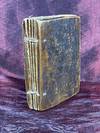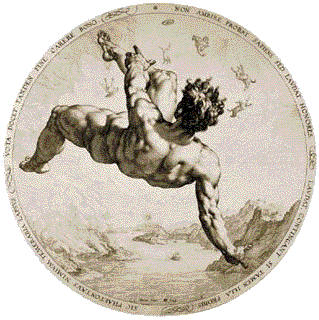1925 · Ethiopia
by Anonymous Ethiopian scribe
Ethiopia, 1925. Manuscript on heavy parchment (115 x 80 mm). Collation: A12 (-A1) B10 C8 D8 = 37 (of 38) ff. Traditional Ethiopian coptic binding structure of hewn wooden boards, exposed string outside quires, looped and tied back onto the twine itself. Back board split vertically with old repair consisting of two thick twine knots cinching the two pieces together. In very good condition, suitable for exhibition and study. A MODEST BUT COMPLETELY UNSOPHISTICATED ETHIOPIAN COPTIC MANUSCRIPT, IN EVERY WAY "NON-WESTERN," WRITTEN ON ROUGH PARCHMENT AND BOUND IN THE COPTIC MANNER WITHIN TWO ROUGHLY HEWN WOODEN BOARDS. THIS IS A PERFECT TEACHING EXAMPLE FOR STUDENTS OF THE BOOK ARTS, PARTICULARLY VALUABLE IN THAT THE TEXT IS OF AN UNUSUAL TYPE AND IS VIRTUALLY COMPLETE, LACKING ONLY ONE LEAF OF TEXT.
THIS MANUSCRIPT HAS BEEN COMPLETELY DIGITIZED (59 images - please inquire).
Our manuscript exhibits many intriguing features. The text is written in Ge'ez, the classical language of Ethiopia. Whereas Ge'ez is now almost extinct, it is still used as the primary liturgical language by Ethiopian Christians and Ethiopian Beta Israel Jews.
Due to Ethiopia's relative political and cultural insularity from Europe during the early Christian era and even into the 19th century, the actual technical process of creating manuscripts in this region has remained relatively unchanged for centuries (indeed well into the early twentieth century). Indeed, Ethiopia has a vibrant history of manuscript production for over a thousand years. The continual production and dissemination of these books over centuries speak to a long and complex literary and religious history. These manuscripts are often notable for their binding construction, today known as "coptic," which is completely different than is typical of most codices bound in medieval Europe: here a single chain stitch is laced through the quires, onto the outside of the exposed spine, uniting them together and to the boards which protect them. Our manuscript provides a excellent example of this ancient technique.
Our manuscript contains three Sälams (literally "peace" or "salutation") which date from the 15th century and are hymns or poems written in honor of saints or a religious figure, and consist of verses that begin with the words "ሰላም ፡ ለኪ ፡" (hence "Salams") as here. The three Sälams are identified in the present manuscript by means of simple knotwork pen and ink horizontal ornament. They are:
Sälam to the Virgin Mary (our image numbers IMG 4367 > 4380)
Sälam to Jesus Christ (IMG 4380 > 4392)
Sälam to the Archangel Michael (IMG 4392 > 4403).
The spaces in the text that allow for the usual rubrics (e.g. names of Mary, Christ, etc.) are not long enough, so the names appear here in abbreviated form.
At the end of the text, written in a rough hand, is the name of Qés (i.e. Priest) Gétenät Gäbrä Mäsqäl, apparently named after Gabra Masqal, King of Axum, who reigned in the 6th century. It was during Gabra Masqal's reign that the Ethiopian saint Yared composed some of the greatest religious hymns ever written, and is credited with being the forerunner of traditional music in Ethiopia, much of which has remained UNCHANGED for almost 1500 years.
COMMENT: The most sublime recordings of Ethiopian Coptic music we have ever encounted is the absolutely mesmerizing 1960s Unesco sponsored LP entitled "Ethiopian I: Copts - Music of the Ethiopian Coptic Church" (in: Anthology of African Music / Bärenreiter-Musicaphon). Interested parties are strongly encouraged to listen to the entire album over and over, as we have done for many years. We are invariably devastated by tracks 3 ("The Kings Come with Gifts. Antiphonal Chanting"), 5 ("Priests Beat the Drums. Congregation Joins with Sistra") and 6 ("Prayer of Thanksgiving in the Ge'ez Zema"). The album was uploaded to youtube by World Field Recordings in Feb. 2025. "Praise be!"
CATALOGUER'S NOTE: As ever we are grateful to Prof. David Appleyard for his research and scholarly generosity; without him the present description could not have been written. (Inventory #: 4389)
THIS MANUSCRIPT HAS BEEN COMPLETELY DIGITIZED (59 images - please inquire).
Our manuscript exhibits many intriguing features. The text is written in Ge'ez, the classical language of Ethiopia. Whereas Ge'ez is now almost extinct, it is still used as the primary liturgical language by Ethiopian Christians and Ethiopian Beta Israel Jews.
Due to Ethiopia's relative political and cultural insularity from Europe during the early Christian era and even into the 19th century, the actual technical process of creating manuscripts in this region has remained relatively unchanged for centuries (indeed well into the early twentieth century). Indeed, Ethiopia has a vibrant history of manuscript production for over a thousand years. The continual production and dissemination of these books over centuries speak to a long and complex literary and religious history. These manuscripts are often notable for their binding construction, today known as "coptic," which is completely different than is typical of most codices bound in medieval Europe: here a single chain stitch is laced through the quires, onto the outside of the exposed spine, uniting them together and to the boards which protect them. Our manuscript provides a excellent example of this ancient technique.
Our manuscript contains three Sälams (literally "peace" or "salutation") which date from the 15th century and are hymns or poems written in honor of saints or a religious figure, and consist of verses that begin with the words "ሰላም ፡ ለኪ ፡" (hence "Salams") as here. The three Sälams are identified in the present manuscript by means of simple knotwork pen and ink horizontal ornament. They are:
Sälam to the Virgin Mary (our image numbers IMG 4367 > 4380)
Sälam to Jesus Christ (IMG 4380 > 4392)
Sälam to the Archangel Michael (IMG 4392 > 4403).
The spaces in the text that allow for the usual rubrics (e.g. names of Mary, Christ, etc.) are not long enough, so the names appear here in abbreviated form.
At the end of the text, written in a rough hand, is the name of Qés (i.e. Priest) Gétenät Gäbrä Mäsqäl, apparently named after Gabra Masqal, King of Axum, who reigned in the 6th century. It was during Gabra Masqal's reign that the Ethiopian saint Yared composed some of the greatest religious hymns ever written, and is credited with being the forerunner of traditional music in Ethiopia, much of which has remained UNCHANGED for almost 1500 years.
COMMENT: The most sublime recordings of Ethiopian Coptic music we have ever encounted is the absolutely mesmerizing 1960s Unesco sponsored LP entitled "Ethiopian I: Copts - Music of the Ethiopian Coptic Church" (in: Anthology of African Music / Bärenreiter-Musicaphon). Interested parties are strongly encouraged to listen to the entire album over and over, as we have done for many years. We are invariably devastated by tracks 3 ("The Kings Come with Gifts. Antiphonal Chanting"), 5 ("Priests Beat the Drums. Congregation Joins with Sistra") and 6 ("Prayer of Thanksgiving in the Ge'ez Zema"). The album was uploaded to youtube by World Field Recordings in Feb. 2025. "Praise be!"
CATALOGUER'S NOTE: As ever we are grateful to Prof. David Appleyard for his research and scholarly generosity; without him the present description could not have been written. (Inventory #: 4389)




















![[AMERICAN HERBARIUM 1883-1903]. Meticulously compiled and crafted Herbarium Notebook containing 58 botanical specimens from around the globe](https://d3525k1ryd2155.cloudfront.net/h/852/432/1681432852.0.m.jpg)
